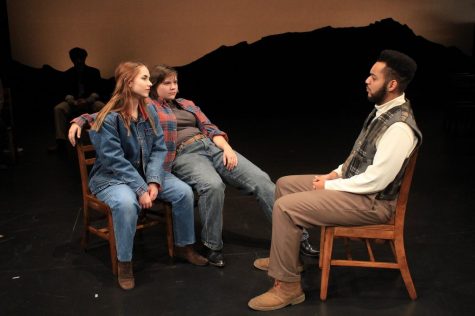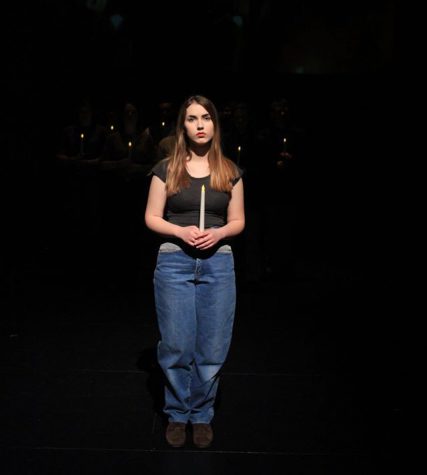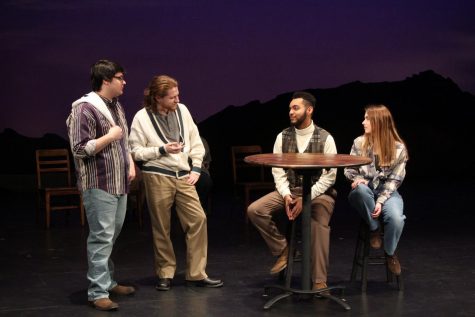“The Laramie Project” is a raw and emotional theatrical take on a real-life tragedy
IU Southeast Theater Department’s latest production is a dramatic play written by Moisés Kaufman and the Tectonic Theater Project
December 17, 2019
In 1998, Matthew Shepard, a 21-year-old gay college student from Laramie, Wyoming, was murdered by Aaron McKinney and Russell Henderson. The events surrounding the tragedy were later written about in “The Laramie Project.”
IU Southeast’s Theater Department hosted a production of Moisés Kaufman’s play from Dec. 5-8. “The Laramie Project” was written by Kaufman and the members of the Tectonic Theater Project.
The play itself is adapted from interviews done by the theater company with Laramie residents, journal entries from the theater company and news reports about Shepard’s murder.
There was an ensemble cast that included Katie Graviss Bechtler, Gracie Kaine, Mason Lin, Connor Madison, Dylan Nash, Cindy Schrader, Rachel Street, Wesley Stroud, Rebecca Von Allmen and Jaime Young. Each actor or actress played a minimum of five characters throughout the show and one actor even played ten.
With the exception of one cast member, all of the actors and actresses were either freshmen at IU Southeast or appearing onstage at IU Southeast for the very first time. Both community members and IU Southeast students played roles in the production.
J. Barrett Cooper, an adjunct lecturer of directing and stage combat at IU Southeast, directed the production.
The play was produced in conjunction with the IU Southeast Common Experience Program.

Costume and Character Changes
The costume changes in the production were done in a very unique way. The costume racks were on both sides of the stage for the entire show and almost every costume change was done onstage in front of the audience.
The costume changes were simple yet effective, mainly consisting of putting on a jacket or a hat.
The character changes were done in a similar fashion to the costume changes. Almost all of them were done onstage. If actors or actresses were not in a scene, most of the time they would be sitting in chairs at the back of the stage participating as observers to the scene.
Overall, the character changes were done fairly well. There were only one or two instances throughout the show where it was mildly confusing to tell which character was being portrayed.
Both mildly confusing instances were due to one actor or actress playing more than two roles in their own individual scene where the characters were all interacting with one another. As long as the audience paid close attention, however, it was not that much of an issue.
Four actors and actresses that switched characters almost flawlessly onstage were Betchler, Schrader, Von Allmen and Young. Each actor or actress played at least six parts while Young played an outstanding amount of ten parts.

Even though they each played a large amount of roles, their characterization for all of their characters was on point. Betchler’s portrayal of Reggie Fluty, Von Allmen’s portrayal of Romaine Patterson, Young’s portrayal of Doc O’Conner and Schrader’s portrayal of Marge Murray were all highlights of the production.
Technical Aspects
The set design for “The Laramie Project” was very minimalistic, but that is common across all productions of the play. The only set pieces used were wooden chairs, costume racks and a few wooden tables.
There were many technical concepts in the production that were done well, including the use of a projection screen, audio clips and unique lighting effects.
The projection screen behind the stage was used in almost every scene to portray the changing colors of a beautifully lit sky with twinkling stars appearing every so often to demonstrate how the town of Laramie sparkled.
The screen was also used on various occasions to show real footage from a candlelight vigil for Shepard and various coverage of the trial of Henderson and McKinney.
The integration of audio clips, singing and dialogue in some scenes made the content of the scene much more emotional rather than if the scene only contained dialogue and blocking. The song “Amazing Grace” was used in multiple scenes and made those particular scenes much more emotional.
One unique lighting effect was the use of light shaped like the outline of angels used in a very powerful and emotional scene that depicted Romaine Patterson and Fred Phelps’ standoff at the trials of Henderson and McKinney.
Patterson, played by Von Allmen, came up with a plan to deflect the hate that Phelps, played by Stroud, brought to one of the trials by picketing it. That plan was called “Angel Action.”
“Angel Action” was intended to take away the hate that Phelps and the Westboro Baptist Church brought to the trial by having individuals dress up as angels with giant angel wings and block out the hate. The angel wings from the costumes would surround Phelps and prevent the people who were attending the trial from seeing and hearing Phelps.
The substitution of lights shaped like the outline of angels shining on Patterson instead of having the cast dress up in angel costumes was an interesting and minimalistic take on the scene. The lights uniquely symbolized all of the protection and acceptance that was used to combat against Phelps’ hate and negativity.

Final Thoughts
The IUS Theater Department’s production of “The Laramie Project” was an emotional and at times vulnerable show that gave audiences a more in-depth look into the effects of a troubling tragedy on a close-knit community. The minimalist nature of the show allowed the acting and technical effects to shine through.
“The Laramie Project” has already finished its run in the Ogle Center, but the theater department’s production of “Vanya and Sonya and Masha and Spike” will run in the Ogle Center from Feb. 21-23 and from Feb. 28 to March 1, 2020.


